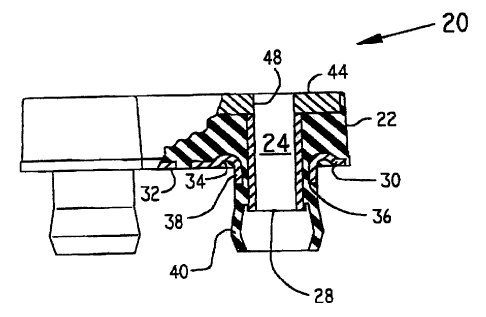Some of the information on this Web page has been provided by external sources. The Government of Canada is not responsible for the accuracy, reliability or currency of the information supplied by external sources. Users wishing to rely upon this information should consult directly with the source of the information. Content provided by external sources is not subject to official languages, privacy and accessibility requirements.
Any discrepancies in the text and image of the Claims and Abstract are due to differing posting times. Text of the Claims and Abstract are posted:
| (12) Patent: | (11) CA 2231878 |
|---|---|
| (54) English Title: | SINGLE-PIECE MOUNT WITH SPLIT METAL PLATES |
| (54) French Title: | SUPPORT MONOBLOC A PLAQUES METALLIQUES FRACTIONNEES |
| Status: | Deemed expired |
| (51) International Patent Classification (IPC): |
|
|---|---|
| (72) Inventors : |
|
| (73) Owners : |
|
| (71) Applicants : |
|
| (74) Agent: | NORTON ROSE FULBRIGHT CANADA LLP/S.E.N.C.R.L., S.R.L. |
| (74) Associate agent: | |
| (45) Issued: | 2003-09-30 |
| (86) PCT Filing Date: | 1996-06-19 |
| (87) Open to Public Inspection: | 1997-03-20 |
| Examination requested: | 1999-08-25 |
| Availability of licence: | N/A |
| (25) Language of filing: | English |
| Patent Cooperation Treaty (PCT): | Yes |
|---|---|
| (86) PCT Filing Number: | PCT/US1996/010572 |
| (87) International Publication Number: | WO1997/010466 |
| (85) National Entry: | 1998-03-12 |
| (30) Application Priority Data: | ||||||
|---|---|---|---|---|---|---|
|
A single-piece elastomeric mount (22) installed over a plurality of openings
(15) has a like plurality of reinforcing plates (44 and 46) to permit the
elastomeric rib between the plates' edges to flex. The apertures (24 and 26)
in the mount can then be aligned with holes (15) in a support (13) having
wider tolerances on their end positions. The mount may include two sets of
plates - an upper load-distribution set (44 and 46) and a lower wear-reducing
set (30 and 32), each set being bonded to the elastomer.
L'invention porte sur un support monobloc élastomère (22) placé sur une pluralité d'ouvertures (15), lequel comprend une pluralité identique de plaques de renfort (44 et 46), la nervure élastomère située entre les bords des plaques étant ainsi flexible. Les orifices (24 et 26) pratiqués dans le support peuvent être alors alignés avec les ouvertures (15) pratiquées dans un support (13) et ayant des tolérances plus importantes aux extrémités. Le support peut inclure deux séries de plaques: une série supérieure (44 et 46) de répartition de charge, et une série inférieure (30, 32) réduisant l'usure, chacune de ces séries étant rattachée à l'élastomère.
Note: Claims are shown in the official language in which they were submitted.
Note: Descriptions are shown in the official language in which they were submitted.

For a clearer understanding of the status of the application/patent presented on this page, the site Disclaimer , as well as the definitions for Patent , Administrative Status , Maintenance Fee and Payment History should be consulted.
| Title | Date |
|---|---|
| Forecasted Issue Date | 2003-09-30 |
| (86) PCT Filing Date | 1996-06-19 |
| (87) PCT Publication Date | 1997-03-20 |
| (85) National Entry | 1998-03-12 |
| Examination Requested | 1999-08-25 |
| (45) Issued | 2003-09-30 |
| Deemed Expired | 2005-06-20 |
There is no abandonment history.
| Fee Type | Anniversary Year | Due Date | Amount Paid | Paid Date |
|---|---|---|---|---|
| Registration of a document - section 124 | $100.00 | 1998-03-12 | ||
| Application Fee | $300.00 | 1998-03-12 | ||
| Maintenance Fee - Application - New Act | 2 | 1998-06-19 | $100.00 | 1998-06-17 |
| Maintenance Fee - Application - New Act | 3 | 1999-06-21 | $100.00 | 1999-06-15 |
| Request for Examination | $400.00 | 1999-08-25 | ||
| Maintenance Fee - Application - New Act | 4 | 2000-06-19 | $100.00 | 2000-06-12 |
| Maintenance Fee - Application - New Act | 5 | 2001-06-19 | $150.00 | 2001-06-04 |
| Maintenance Fee - Application - New Act | 6 | 2002-06-19 | $150.00 | 2002-06-07 |
| Final Fee | $300.00 | 2003-02-20 | ||
| Maintenance Fee - Application - New Act | 7 | 2003-06-19 | $150.00 | 2003-06-19 |
Note: Records showing the ownership history in alphabetical order.
| Current Owners on Record |
|---|
| LORD CORPORATION |
| Past Owners on Record |
|---|
| DORTON, DAVID W. |